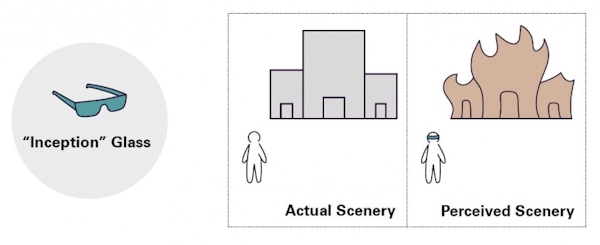[From Digital Trends, where the story includes more images and a 0:31 minute video]
Sony’s creating ‘Inception Glasses’ that will bend city streets and buildings around you
By Jeremy Kaplan – September 24, 2014
Here’s one way to make the mountain come to Mohammed.
In the 2010 Christopher Nolan film Inception, Leonardo DiCaprio and Ellen Page create impossible dream environments by folding whole city blocks in upon themselves. It’s remarkable to see – so remarkable that Sony Computer Science Lab researcher Yuichiro Takeuchi decided to make the science fiction conceit into a reality.
On Monday he unveiled the technology, running at present on a tablet but with plans to release a wearable version that runs in glasses. Takeuchi showed a video in which the giant arch in New York City’s Washington Square Park shimmied and rippled in the breeze like a belly dancer. He followed up with a video showing various buildings growing and collapsing like Shrinky-Dinks.
The connection to the film is no coincidence: Takeuchi calls his idea “Inception Glasses,” and he’s got plans to solve real-world problems with them.
“In dense cities like Tokyo or Manhattan, you never know if there’s a car around a corner. Inception glasses can make buildings transparent,” he said. Or they could make it easy for a newcomer to a big city, by flattening out or scaling down the heights of surrounding buildings to make a destination easier to discover. Or — and this sounds fantastic to our ears — adjusting the heights of different nearby restaurants based on Yelp reviews.
Want Middle Eastern food, but hate bad babaganoush? Just steer yourself for the tallest building in the area. And if those ideas are too complex, there’s always a fallback for Inception glasses.
“If nothing else, it makes a great urban gaming environment,” Takeuchi said.
The researcher unveiled his concept at the Museum of Modern Art Monday at “The Point of Knowing,” the first ever U.S. symposium from Sony Computer Science Laboratories, a pure research arm of the Japanese company that aims ultimately to solve the world’s biggest problems: food shortages, depletion of natural resources, poverty, power, and so on.
“Our mission is much broader: What is a problem in the world and how can we solve it?” asked Hiroaki Kitano, Director of Research and President and CEO of Sony CSL, in his opening remarks. Kitano is a fast-talking 53 year old, with a B.A. in physics from Tokyo’s International Christian University, a Ph.D. in computer science from Kyoto University, and a string of awards and research papers that dates back decades. He’s also partial to prognostication.
“A fully autonomous robot soccer team will beat a human FIFA soccer team by the middle of the century,” he declared. (We’ll see about that.)
The Symposium lasted three and a half hours and covered a wide array of topics. Annette Werth, an Italian living in Tokyo on her first trip to the United States, detailed an on-going project to transform the world’s power system through local, eco-friendly microgrids that interconnect and share energy via peer-to-peer communication.
Masatoshi Funabashi, Sony’s resident gardener and beekeeper (really), detailed ecosystem curation, something essential to the obscure field of synecoculture he studies. This field aims to explode current techniques of agriculture by rethinking how we plant crops. One benefit: a big boost to the number of foods used by humans, currently only 150 to 200 of the 7,000 plants known to be edible.
You look out at a garden and might see weeds. He sees art.
“In our garden, we have a lot of Rothkos,” Funabashi told the crowd.
In addition to his Inception Glasses, Takeuchi described a way to print not buildings but everything around them, the landscape. He’s designed a system that creates 3D-printed hydroponic gardens made of felt or sponge, or in his case, yarn, and then “printing” or planting little seeds in them.
“Printing buildings, that’s a fascinating idea, no doubt about it. But we already have mechanisms for that.” He can currently print out shelf-sized gardens. He’s dreaming of city-scale printing.
Other presentations beautifully mixed art and science. A fascinating presentation by Alexis Andre walked through “interactive aesthetics,” his way of answering “boring” questions like “can you touch sound?” (The answer: yes, and it’s simply beautiful.) And Francois Pachet, head of Sony CSL’s Parisian arm, ended the symposium by describing his efforts to capture and recreate a musician’s sound – not just a song he has written but how the artist would approach a unique piece. His software, dubbed FlowComposer, can create music in the style of any artist – “California Girls” as played by John Coltrane, or what have you.
Jun Rekimoto – labelled “a genuine geek” by one of his colleagues – walked through a dizzying array of ways to augment the human body, ranging from simple knives and screwdrivers to drone’s-eye-view systems and augmented reality swimming pools. Via remote connection from Tokyo, Ken Endo detailed work on another form of augmentation, a prosthetic limb that can enhance in addition to aiding the disabled.
“Technology should make us happier and more active,” Rekimoto sad.
That’s a vast array of topics, but all important ones. Ultimately, the goal of a research facility like Sony’s should be this wide spread and far-reaching, explained Sony CSL founder Mario Tokoro.
“We need a fresh look, all the time.”
